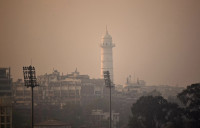Opinion
Talking through their hat
Every Nepali is excited about the approaching provincial and federal elections. As is the practice, all political parties present their vision and goals in the form of an election manifesto.
Dr Nirmal Kandel
Every Nepali is excited about the approaching provincial and federal elections. As is the practice, all political parties present their vision and goals in the form of an election manifesto. So what programmes do they have for the health sector? The health system can be shown in the form of a tree diagram. The roots are the six building blocks of the health system: governance and leadership, financing, health workforce, health services, medical products and technologies and information. The fruits of the health system are improved responsiveness, efficiency and equity and financial protection. The tree’s growth depends on external factors like research, quality, education, economy, access, collaboration and various principles and characteristics.
All political parties have called health a basic human right. Typically, populist goals dominate their manifestos and they lack vision. They have all put health insurance and free health service at the top of the agenda, but not one has said where the money is going to come from. Health service is considered to be the state’s responsibility and part of socio-economic reform and social security, but the parties have not said how this reform or social security net will be expanded. There must be policy guidance at the national level. All political parties seem to believe in pluralism in health delivery and have emphasised collaboration with the private sector.
Addressing gaps
Financing is one of the areas which has been given much space in the election manifestos. The obvious reason is the planned national health insurance bill and provision of free health services. This sounds perfect and achievable when the country has adequate financial resources. However, the parties have not indicated how funding will be obtained to achieve these goals.
The health workforce is one of the poorly delineated components in the manifestos. They have talked about increasing the pay and benefits of health workers, barring government doctors from engaging in private practice and assigning doctors who received scholarships to rural hospitals. But there is nothing about human resource strategies like recruitment, mobilisation to remote and rural areas, retention of health care workers, and need-based training and education.
Health service is covered extensively in every party’s manifesto, but it is too focused on curative care instead of preventive care. This section can be divided into infrastructure development; curative care and disease control; maternal, child and reproductive health; and emergency preparedness and response. With regard to infrastructure development, all manifestos talk about building hospitals with 15-50 beds in every village and municipality. This is in no way achievable and is not based on scientific rationale or need. Hospitals should be built based on population density and accessibility of the villages and municipalities.
All manifestos talk about providing free health care for serious non-communicable diseases like heart disease, diabetes, kidney disease, lung disease and cancer. This goal can only be achieved by implementing health insurance. Nepal has made significant achievements in terms of maternal and child health. Sustaining these achievements is difficult.
Emergency preparedness and response is one of the weakest sections in the election manifestos. The parties don’t have a clear vision or goals in terms of emergency preparedness and response in a country that faces frequent natural disasters. Nothing has been mentioned except for provision of free health services for those affected by natural disasters. Parties need to work together and have a clear policy and strategy for addressing emergencies by having robust preparedness and response strategies.
Providing free essential medicines, developing infrastructure with modern technologies and conserving herbal products and industries have been mentioned briefly in the election manifestos. Strengthening this area will increase efficiency and save lots of resources. For example, modernising and establishing government drug companies will ensure that all health facilities have effective and quality essential drugs. This should be a priority for the next government in order to achieve universal health coverage and health.
Information is the backbone of any system. Except for vital registration of children and free access to the internet, nothing else has been mentioned about information system development and utilisation. This is connected with disease surveillance, monitoring and evaluation of universal health coverage, health programmes and intervention and health governance. Information ensures credibility and accountability of the political parties or government and assists informed decision making.
External efforts
Some external factors that are necessary for the growth of the health system ‘tree’ have been mentioned in the election manifestos: collaboration with the animal health sector, research development and health education, provision of access to health services in remote parts of the country, door-to-door services for public health and provision of access to safe water and sanitation. However, whoever forms the government after the election should ensure collaboration and coordination with other sectors because health is multi-sectoral. It should strategise about providing access to people of remote areas, ensure research and development in health and prevent commercialisation of health education.
Tourism is a major source of income for the country, and the health sector can contribute to economic development through medical tourism. One of the political parties has proposed developing Nepal as a medical tourism destination. However, to achieve this goal, the next government will need to establish internationally accredited hospitals and ensure quality care. Thailand and India are a few of the medical tourism destinations in the world, and the hospitals there have been making a big contribution to their overall economic development. None of the election manifestos are perfect or bad, and they have covered most of the elements of health system development. Whoever forms the next government should study them. There is always something that can be learned from different groups and views.
Kandel is a public health physician based in Geneva




 8.12°C Kathmandu
8.12°C Kathmandu











